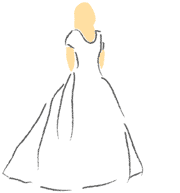Superstition: The lore and symbolism surrounding wedding gowns.
Origins: Everyone knows "Something old, something new, something borrowed, something blue," but that rhyme is merely the beginning of bridal attire superstitions, not the all of them.
What

has come to be viewed as the "traditional" white wedding dress is of recent invention. Up until Victorian times brides decked themselves out in their best finery; they did not rush out to buy something new for the occasion. The ostentatiously impractical white dress became popular among the Victorian upper classes chiefly for its defects: one had to be well off to afford such an opulent creation, one which would be worn only once.
Because the bride is entering a new phase of her life, with the exception of a maximum of one item apiece to satisfy the "something old" and "something borrowed" requirements, everything she wears on her wedding day should be brand new, right down to her shoes.
Unlucky is the bride who makes her own dress, yet it is even more unlucky for her to don full bridal array too soon, particularly if she catches sight of herself clad thus. Premature anticipation of this sort may cause something to happen to prevent the marriage. Only when the bride is on the point of leaving for the ceremony is it safe for her to look at herself fully robed and veiled. Even then, it is considered prudent to leave off one small item (a glove, for instance) to be donned
afterwards.
While the dress is being fitted, it should be put on in sections and never all at once. If possible, it should not be finished before the day on which it is to be worn. Sometimes a bit of hem is purposely left unsewn so that those last finishing stitches can be added at the very last moment to avoid any evil that might come from wearing the dress prematurely.
The color of the gown is deemed crucial in terms of what sort of luck it will attract to the marriage. White, silver, blue, pink, and gold are now considered the luckiest shades. Blue has always been popular because it signifies constancy, and often bridal favors are deliberately shaded this color to take advantage of its lucky properties. In former times, knots of blue ribbons were loosely stitched onto the wedding dress to later be plucked off by guests at the wedding feast and worn as luck-bringers on the hats of young men.
Contrary to what many have come to think, a white wedding gown has little to do with advertising the virginity of the bride. That construct appears to be a modern one; little in lore suggests it dates back very far at all.
White is about as impractical a color as one can come up with, and those Victorians looking for a way to make an unseemly show of wealth socially acceptable knew that. A white dress was its own advertisement that it wasn't going to be worn again.
Moreover, white is traditionally the color associated with joy. Roman brides were clad in white for this reason. Church vestments at Easter are also white for the purpose of expressing joy.
A white-clad bride is one who advertises her happiness, not her purity.
Nothing black should be worn by the bride, else she risk becoming a young widow.
Green is also an unfortunate color because of its associations with fairies, and its wearing is also said to foretell a change into clothes of mourning. Green has been deemed so unlucky that in Lowland Scotland neither bride nor guests would consider wearing it to a wedding, no green was permitted in the decorations, and even green vegetables were banned from the bridal feast menu.
Brown is avoided because of an old belief that says those who wear it "will never live in town," a statement taken to mean their husbands will never rise in business or otherwise acquire riches that would enable the family to move up to finer surroundings.
Yellow is widely disliked because it signifies 'foresworn.'
Purple is out because it is seen as a mourning color, one favored by widows from their second year of bereavement onward.
The world of lore has placed such cautions and recommendations in the form of a rhyme:
Married in green, Married in red, Married in blue, Married in yellow, Married in black, Married in pink,
Married in white,
You have chosen all right.
Ashamed to be seen.
You will wish yourself dead.
You will always be true.
Ashamed of your fellow.
You will wish yourself back.
Of you he'll think.
What to make the dress of is every bit as important as how to construct it or what color to choose. Silk is the preferred material. Satin brings bad luck, and velvet threatens the wearer with poverty. Unpatterned fabric is deemed best, but if a patterned style must be risked, on no account should the pattern include the forms of birds or vines.
Barbara "wear at your own apparel" Mikkelson
Last updated: 27 June 2005
 Sources:
Sources:
